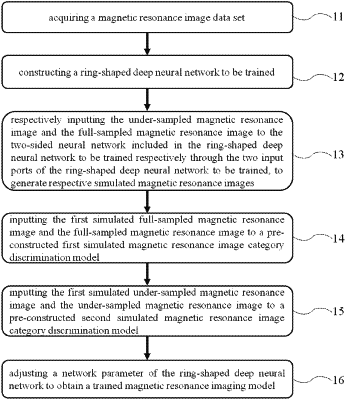| CPC G06V 10/774 (2022.01) [A61B 5/055 (2013.01); G06T 11/00 (2013.01); G06V 10/42 (2022.01); G06T 2210/41 (2013.01)] | 14 Claims |

|
1. A method for training a magnetic resonance imaging model, comprising:
acquiring a magnetic resonance image data set comprising an under-sampled magnetic resonance image and a full-sampled magnetic resonance image;
constructing a ring deep neural network to be trained, wherein the ring deep neural network comprises a first neural network at a first side, a second neural network at a second side, and two input ports respectively for the under-sampled magnetic resonance image and the full-sampled magnetic resonance image, wherein the first neural network is configured to generate a first simulated full-sampled magnetic resonance image based on the under-sampled magnetic resonance image and generate a second simulated full-sampled magnetic resonance image based on a first simulated under-sampled magnetic resonance image generated by the second neural network, and the second neural network is configured to generate the first simulated under-sampled magnetic resonance image based on the full-sampled magnetic resonance image and generate a second simulated under-sampled magnetic resonance image based on the first simulated full-sampled magnetic resonance image generated by the first neural network;
inputting the under-sampled magnetic resonance image and the full-sampled magnetic resonance image respectively to the first neural network and the second neural network via the two input ports, to generate respective simulated magnetic resonance images comprising the first simulated under-sampled magnetic resonance image, the first simulated full-sampled magnetic resonance image, the second simulated under-sampled magnetic resonance image and the second simulated full-sampled magnetic resonance image;
inputting the first simulated full-sampled magnetic resonance image and the full-sampled magnetic resonance image to a pre-constructed first simulated magnetic resonance image class discrimination model, to obtain a first discrimination result indicating whether or not the first simulated full-sampled magnetic resonance image is of a simulated magnetic resonance image class;
inputting the first simulated under-sampled magnetic resonance image and the under-sampled magnetic resonance image to a pre-constructed second simulated magnetic resonance image class discrimination model, to obtain a second discrimination result indicating whether or not the first simulated under-sampled magnetic resonance image is of the simulated magnetic resonance image class; and
adjusting a network parameter of the ring deep neural network based on a preset loss function, the first discrimination result, the second discrimination result, the second simulated under-sampled magnetic resonance image, the second simulated full-sampled magnetic resonance image, the under-sampled magnetic resonance image and the full-sampled magnetic resonance image, to obtain a trained magnetic resonance imaging model.
|